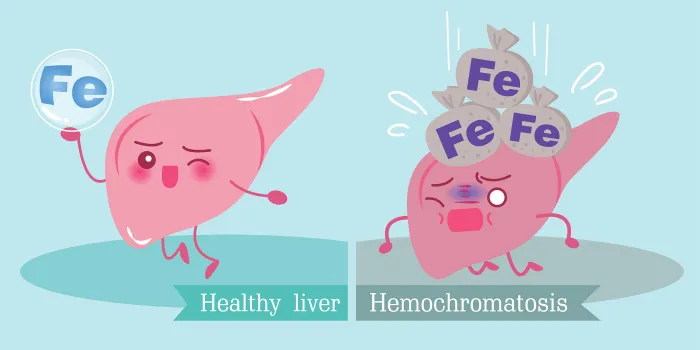Hemochromatosis, also known as iron overload disorder, is a condition in which people have too much iron in their blood. More than 1 million Americans have the disease, which can cause damage to the liver, joints, pancreas, and heart.
For people with hemophilia, the effects of hemochromatosis may seem familiar in that the disease causes joint damage (among other symptoms) due to abnormalities in the blood. Other complications can include liver cirrhosis, diabetes due to damage to the pancreas, and cardiovascular problems caused by excess iron in the heart.
Read on for a rundown of hemochromatosis, its causes, symptoms, and treatments.
Causes of Hemochromatosis
Hemochromatosis is a disease in which the body stores too much iron in the blood. Most often, it is inherited genetically, which is referred to as primary hemochromatosis. This form of the disease is a result of problems with DNA from both parents that cause the body to absorb too much iron. More specifically, the greatest risk factor for primary hemochromatosis is having two altered copies of the HFE gene, which controls iron absorption.
Secondary hemochromatosis is not inherited, and instead is caused by anemia, alcoholism, iron pills or injections, and kidney dialysis over a long period. People with certain types of anemia or liver disease need frequent blood transfusions, which can lead to excess iron buildup and iron overload. Thalassemia, an inherited blood disorder in which your blood carries less hemoglobin than normal, can also cause secondary hemochromatosis. The disease leads to anemia and requires frequent blood transfusions, causing iron overload.
Hemochromatosis is more common in men than women, as the latter lose iron during their periods and during pregnancy; women’s bodies also store less iron. The disorder is more common in older people as well, because iron toxicity takes years to develop.
Symptoms of Hemochromatosis
Not everyone with this disorder develops symptoms, and people who do develop symptoms may not experience them until middle age. Symptoms of hemochromatosis include:
- Fatigue
- Feeling weak
- Weight loss
- Joint pain, often in the knees and hands
- Bronze or gray skin color
- Abdominal pain over the liver
- Loss of sex drive or erectile dysfunction
- Absence of the menstrual cycle
How Is Hemochromatosis Diagnosed?
It can be difficult to diagnose hemochromatosis on certain symptoms alone, as things like fatigue and joint pain can be attributed to so many other factors. The disorder is most often discovered through blood tests that detect higher-than-normal levels of iron. People with a family history of the disorder should get tested even if they show no symptoms.
Additional testing may include liver function tests or liver biopsies to detect damage or measure iron levels, MRIs to determine the level of iron overload in the liver, and DNA tests to identify changes in the HFE gene if you have high levels of iron in your blood.
How Is Hemochromatosis Treated?
There is no cure for hemochromatosis, but several measures can help lower iron levels in the blood to ease symptoms and minimize complications. One treatment is regular phlebotomies, or blood draws. Drawing blood on a regular basis removes red blood cells that contain iron and forces your body to use up more iron to replace them, resulting in a net loss of iron in the blood.
Chelation therapy is another way to reduce the amount of iron in the blood. This procedure involves administering medicines (via IV or pill) that bind to iron and other metals in the blood and cause the body to excrete them through urine. Chelation therapy is done in cases where regular phlebotomies aren’t possible.
People with hemochromatosis can also take dietary measures, such as avoiding supplements containing iron or vitamin C (which increases the absorption of iron). Avoiding alcohol can also help, as alcohol increases the risk of liver damage. Staying away from raw fish, shellfish, and red meat may be useful, too, as these are rich in iron.

